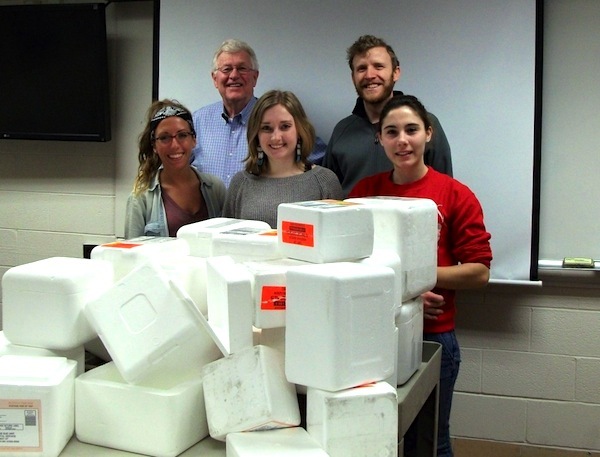UW–Madison Styrofoam reuse and recycling program wins competition

UW-Madison’s Styrocycle team won a $90,000 award to expand its Styrofoam reuse and reccyling program in the Madison area. Team members include in the front row, left to right, Katelyn Budke, Jenna Walsh and Emily Baumann. In the rear are team advisers Frank Kooistra and Andrew Markley. Not pictured is team member Jared Ottman.
A team of University of Wisconsin–Madison undergraduates has won a $90,000 award to expand a novel Styrofoam reuse and recycling program in the Madison area.
Students Emily Baumann, Jenna Walsh, Katelyn Budke and Jared Ottmann presented their project, called Styrocycle, at the National Sustainable Design Expo in Washington, D.C., April 25 to 27. Seven of the 35 competing teams received phase II grants in the Environmental Protection Agency’s People, Prosperity, and the Planet (P3) student design competition, which promotes the development of sustainable solutions to everyday problems.
The award will enable the Wisconsin team to expand and prototype their program to reduce packaging waste material through the collection and reuse of bio-shipping containers.
At the event, the team members presented their yearlong efforts to multiple teams of judges and the general public and received an outpouring of interest and questions.
“So many people asked us, where can we recycle our Styrofoam? It was neat to see that we could really make an impact,” says Baumann, the team lead.
Research institutions such as UW–Madison handle an enormous volume of expanded polystyrene (EPS) – better known as Styrofoam – containers and packing material, she says, which are useful for shipping scientific research materials because they are lightweight and insulate well to keep laboratory reagents and samples at a constant temperature.
With the support of the UW–Madison Office of Sustainability, the team won a $15,000 phase I grant last summer to investigate the waste streams, collection systems, reuse options and carbon footprints associated with Styrofoam boxes and other shipping materials including packing peanuts, shipping boxes and reusable freezer gel packs.
“So many people asked us, where can we recycle our Styrofoam? It was neat to see that we could really make an impact.”
Emily Baumann
They found that the production of Styrofoam boxes is labor- and resource-intensive, emitting approximately 2.5 pounds of carbon dioxide equivalent into the atmosphere per box, Walsh said last week in a campus sustainability research presentation.
Styrofoam disposal is also associated with a large environmental cost, since it takes up a lot of space in landfills and does not break down into methane or another harvestable energy source. Local reuse of a Styrofoam box would reduce the box’s carbon footprint by more than 70 percent, they found.
The Styrocycle group has worked with the UW–Madison We Conserve program to establish Styrofoam collection sites in 15 campus buildings and created partnerships with local biotechnology companies, including Aldevron, Stemina Biomarker Discovery and Protein Mods, to reuse the recovered shipping containers.
“We have so many boxes,” Baumann says. “It’s just a matter of getting [the companies] to use the used boxes because it’s so easy for them to just buy new ones.”
She says there can be financial incentive for companies to participate in a Styrofoam reuse network because they pay $5 to $12 for a new Styrofoam box but can receive used boxes for free or a small fee.
Styrocycle also coordinates with UW Surplus With A Purpose (SWAP), which sells Styrofoam boxes, packing peanuts, and freezer packs, and Uniek, Inc., a Waunakee-based company that recycles Styrofoam into picture frames and other products.
“We’re recycling 250 shipping boxes a week, and we’re not even getting everything. If we can reuse these things in addition to recycling, and possibly expand it to other campuses, there’s the potential for a really huge impact on a waste stream that’s a huge problem,” says Frank Kooistra, a staff member with We Conserve and the Office of Sustainability who serves as one of the team’s main advisers.
Phase II of the project will last until 2016 and allow the students to expand the Madison networks as well as test the approach at two other universities, Washington University in St. Louis and the University of Illinois at Urbana-Champaign, to define key resources and processes for establishing local networks.
“A main goal is to develop a robust system so that any university can implement something like what we did at their own campus,” says team adviser Andrew Markley, a postdoctoral fellow in chemical and biological engineering.
They are also developing a website to help other institutions evaluate how to create sustainable local Styrofoam networks.
“We will first focus on UW, then hope to make it a hub for EPS recycling nationally,” Baumann says.
One of the most exciting aspects, Markley says, has been watching the students take ownership of a project with the potential for tremendous real-world impact.
“It has been pretty incredible to see them grow from just being academic students to taking on a lot of new roles they hadn’t done. The project is very multidisciplinary, so they were doing things from writing a survey to conducting a lifecycle analysis to carrying out bacterial contamination testing – plus since we’re working on selling the boxes and they’ve been talking with companies, it’s almost like they’ve set up a nonprofit,” he says. “They are changing the culture about how people view Styrofoam. I hope we can use this as a model as to how to turn waste materials into assets.”
The Styrocycle team is: Emily Baumann, biochemistry junior, from Madison; Katelyn Budke, wildlife ecology and environmental studies junior, Bloomington, Minn.; Jared Ottmann, a senior in materials science and engineering with a certificate in engineering for energy sustainability, Salem, Wis.; and Jenna Walsh, biological systems engineering sophomore, Madison.
Tags: environment, student awards, sustainability




